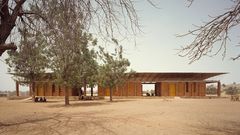On August 2nd 2021 the New York Times published a list in their T Magazine of the 25 most significant works of postwar architecture. The projects are listed in chronological order and among Mies van der Rohe’s Farnsworth House and Luis Barragán’s Casa Luis Barragán, Prof. Francis Kéré’s Gando Primary School made the cut.
The jury, consisting of the architects Toshiko Mori, Annabelle Selldorf and Vincent Van Duysen; the designer Tom Dixon; the artist and set designer Es Devlin; the critic and T contributor Nikil Saval; and Tom Delavan, T’s design/interiors director, picked Kéré’s first project because of its particularly holistic approach on architecture. The Gando Primary School is an outstanding example for Kéré’s work, combining social and environmental aspects by using regional materials, optimizing traditional building techniques and involving the local community in the building process.
Prof. Francis Kéré founded Kéré Architecture in 2005. After teaching at the University of Wisconsin Milwaukee (USA) and the Accademia di Architettura di Mendrisio (Switzerland), Kéré took over the Chair of Architectural Design and Participation at the Technische Universität München in 2017.
